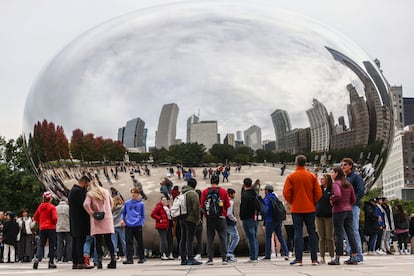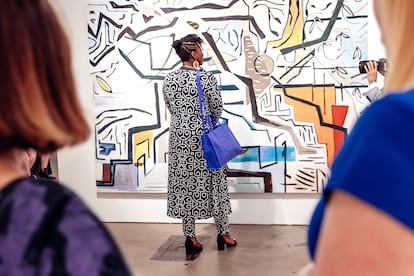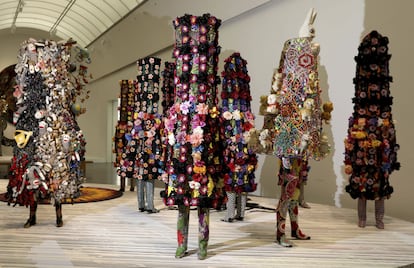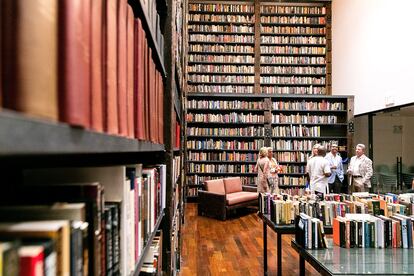Chicago, through the eyes of three art experts: 20 tips so that you don’t miss a thing
Claudia Segura, Theaster Gates and Benedicta Badía share their tips for a creative tour of the city: from its most avant-garde art galleries to a hotel-museum, the Scandinavian neighborhood of Andersonville, and even a bank that has been turned into a library

“It is hopeless for the occasional visitor to try to keep up with Chicago — she outgrows his prophecies faster than he can make them. She is always a novelty; for she is never the Chicago you saw when you passed through the last time,” Mark Twain wrote in 1883. With all due respect to the father of Tom Sawyer and Huckleberry Finn, EL PAÍS consulted three art world experts for their recommendations on discovering Chicago’s artistic side beyond its primary creative hub, the Chicago Art Institute. Benedicta Badía, a consultant at museums like New York’s Guggenheim; Theaster Gates, who is number seven on the annual Power 100 of most influential figures in the world of contemporary art, and Claudia Segura, curator of exhibitions and collections at Barcelona’s Museum of Contemporary Art (MACBA), kindly agreed to take us on tours.
Segura had carte blanche when it came to the curation of the In situ section at her first recommendation: Expo Chicago, the annual contemporary art fair that returns to Navy Pier, located on the shores of Lake Michigan, April 11-14. The building will be filled with intriguing, large-scale sculptures, video installations and site-specific works. “It’s a sustainable fair, where you can buy and sell. But there is also a curatorial exchange program and a meeting of museum directors, so it’s very thought-focused,” Segura says. This year, the event was acquired by Frieze, a global giant among contemporary art fairs. “The city is super-vibrant, with an art scene that has a lot of potential, and a focus on Latino art. In fact, it’s one of the few cities in the United States where billboard ads for exhibitions are often written in Spanish. Based on the architecture of Frank Lloyd Wright and Mies Van der Rohe, and located around the edges of a lake that is nearly an ocean, the city is home to fascinating museums, some of them owned by universities,” she describes.
Of these, Segura mentions DePaul Art Museum, which is operated by the school by the same name, and has a permanent collection composed of more than 3,500 pieces of modern and contemporary art, many of them by Chicago artists, but also individuals from the African and Latin American diasporas, and other groups who are traditionally underrepresented in the art world, such as women and the LGBTQ community. “With a relatively small team, they are able to carry out very powerful exhibitions that nurture the relationship between curators and academics,” Segura says.

The curator also highlights the offerings of galleries that showcase the work of Black figurative artists, including the West Town location of Mariane Ibrahim, a French Somali gallerist who represents artists like Ferrari Sheppard, Zohra Opoku and Lina Iris Viktor. The latter was in the headlines after reaching a settlement with Kendrick Lamar when the rapper used works from her Constellations series in his music video for All The Stars, which appeared on the Black Panther movie soundtrack. “There’s also a lot of interest in the Latin American diaspora at the MCA, a contemporary art museum that shows the work of Chicago artists, but that has a Latin American director, and also a curator, Carla Acevedo, who has reinforced that link.” The museum has hosted exhibitions by Frida Kahlo and Jeff Koons, and its collection includes work from luminaries such as Cindy Sherman and Jasper Johns.

Also among Segura’s suggestions are two projects that offer a certain allure of exclusivity and privilege. The first is The Arts Club, a private club founded in 1916 that exhibits well-curated international contemporary art. It hosted Pablo Picasso’s first show in the United States, back in 1951. Unfortunately, none of the building’s Mies van der Rohe original interiors remain, save for the central stairwell. Her next recommendation is nearby at the 21c Museum Hotel, which is open 24 hours a day at its downtown location, for those who’d like to see the private collection of Laura Lee Brown and Steve Wilson, an art-collecting couple who invite guests and visitors to enjoy their works by 21st-century artists. “From the lobby to the hallways of the hotel, everything is full of pieces from their collection. It’s quite different from the norms of how art tends to be consumed and distributed,” says Segura of the hotel, which has locations in 10 other U.S. municipalities, from Nashville to Kansas City.
With a storied musical legacy, Chicago is also home to surprises like Corbett vs. Dempsey, a gallery that since its opening in 2004 has represented a host of artists who studied at the Chicago Art Institute, like Karl Wirsum and Omar Velásquez. “The space is incredible and its owners are the source of a powerful amount of knowledge. But above all, if you visit, you can’t miss its spectacular library that is dedicated to jazz,” says Segural, who recommends going from there to Document, “a small, honest gallery” that also has a location in Lisbon.
The city’s underground scene is also a can’t-miss aspect of Chicago. The Floating Museum is another one of Segura’s recommendations, which makes a lot of sense, given that just like the curator herself, the museum puts a premium on non-hegemonic discourse. “It’s a hangar in which social practice and civil community come together,” Segura explains. The collective has mounted exhibitions about a river, and inside a subway car. Speaking of rivers, another necessary stop for any art lover is an exploration of local architecture aboard the only Chicago River tour boat associated with the Chicago Architecture Center (CAC). First Lady Cruises offers a 90-minute tour with volunteer guides, who unpack the city’s buildings and the legendary architects who designed them.

A Scandinavian neighborhood
Argentina’s Benedicta Badía is one of the most important art collectors in the world, and her recommendations are closely connected to her critical approach to vanguard work. Her Chicago list challenges the status quo of the city’s artistic community when it comes to non-Western stereotypes and dominant narratives. As such, it’s no surprise that she included LVL3 Gallery, a space founded and run by artists. “They are the ones who really know art,” says Badía. The gallery “fosters the communal, with collaborations between sectors who might not otherwise meet, and international artists from communities that are under-represented in the art market circuit.” If you are interested in the work of emerging and mid-career artists, the is the place for you.
Work by artists who have avoided traditional paths is also the focus at Intuit, an independent museum that was founded in 1991 to highlight artists “who have confronted marginalization and overcome personal obstacles in order to do their work.” Last fall, the organization began a dramatic renovation of its 150-year-old historic building and is slated to reopen this summer.
From there, a long walk in the direction of Lake Michigan brings one to the doors of Wrightwood 659, a light-filled concrete building designed by the Pritzker Award-winning architect, Tadao Ando. The space, located in the Lincoln Park neighborhood, is designed for exhibitions of architecture and socially-conscious art. “It is a unique site of reflection on art as a political and social practice. Its engagement with the narratives of international artists is priceless. While major institutions do show international art, Wrightwood 659 has the agility of an independent center that brings a fresh and revolutionary gaze to Chicago,” says Badía. Her next recommendation is The Renaissance Society, an independent contemporary art museum founded in 1915, dedicated to the commissioning and production of new works by international artists. Here, one can enjoy free concerts, readings and lectures. “The Ren, as it’s called, is not to be missed. It is run by the University of Chicago, one of the most prestigious educational institutions in the world, yet its programming questions the established with the help of pedagogical narratives that interrogate hegemony,” she says.
To conclude, she also recommends a walk through the historically Swedish Andersonville neighborhood. “If you look at a map of how Chicago was formed, you’ll see that Andersonville is where the Swedes settled. To enter the area is to get into the Scandinavian spirit. Here, you can find everything from one of the city’s best feminist bookstores to stores specializing in antique furniture, delicious artisanal bakeries and a small community museum. Homemade goods, design, and urban community are all present in these streets,” says Badía, who hosts one of the hottest parties of Expo Chicago in her art deco penthouse.

A walk through Black Chicago
“No one builds beautiful buildings for Black people in this neighborhood. Why would white people build in Black neighborhoods if they weren’t promised anything in return?” asks Theaster Gates, an artist who was born in East Garfield Park, on Chicago’s West Side. Gates is both a specialist in social art and professor in the department of visual arts at the University of Chicago. He’s also a real force in the art world, according to ArtReview, which ranked him number seven on its latest list of the 100 most influential people in the art world.
We asked Gates to take us on a tour of the neighborhoods where the artistic agitator who is the founder and director of the Rebuild Foundation, a non-profit organization started in 2010 to promote artistic and cultural projects in abandoned spaces largely located in Black and low-income neighborhoods, spends his time. He’s also been part of a project to renovate two abandoned apartments into a refuge for LGBTQ minors who have been kicked out of their family homes.
A tour of Gates’s projects includes a visit to Stony Island Arts Bank, a bank location that was built in 1923 and abandoned in 1979. Gates bought in 2012 so that neighbors would be able to access the works of John H. Johnson, founder and editor of the magazines Ebony (1945) and Jet (1951). The first Black person to appear on the Forbes 400 list in 1982, Johnson’s personal library is now available to anyone who visits the old bank. Here, you can also find the record collection of Frankie Knuckles, the father of house music, alongside art from the University of Chicago and the Chicago Arts Institute.

The Rebuild Foundation is also behind Gates’s next three recommendations for visitors: The Listening House, The Archive House and The Black Cinema House. The latter is a theater located in an abandoned building near South Dorchester Avenue on the city’s South Side. It has screened movies made and starring people from the African diaspora since 2012. A visit to The Archive House, another one of the buildings that have been recovered by the foundation, allows one to take in the impressive, 14,000-book archive that came from a defunct specialized bookstore. The Listening House preserves 8,000 albums from the shelves of Dr. Wax Records.
“I began rebuilding simply because I didn’t have enough money to build what I wanted. Nowadays, there are those who think that our interventions will wind up gentrifying these areas. But at the moment, these neighborhoods are still abandoned and neighbors can still buy a house in them. Our goal is to create an artistic community that is open to the entire world, in these neighborhoods,” says the Chicagoan Gates about his city, which should be visited by any art lover, at least once in their life.
Tu suscripción se está usando en otro dispositivo
¿Quieres añadir otro usuario a tu suscripción?
Si continúas leyendo en este dispositivo, no se podrá leer en el otro.
FlechaTu suscripción se está usando en otro dispositivo y solo puedes acceder a EL PAÍS desde un dispositivo a la vez.
Si quieres compartir tu cuenta, cambia tu suscripción a la modalidad Premium, así podrás añadir otro usuario. Cada uno accederá con su propia cuenta de email, lo que os permitirá personalizar vuestra experiencia en EL PAÍS.
¿Tienes una suscripción de empresa? Accede aquí para contratar más cuentas.
En el caso de no saber quién está usando tu cuenta, te recomendamos cambiar tu contraseña aquí.
Si decides continuar compartiendo tu cuenta, este mensaje se mostrará en tu dispositivo y en el de la otra persona que está usando tu cuenta de forma indefinida, afectando a tu experiencia de lectura. Puedes consultar aquí los términos y condiciones de la suscripción digital.
More information
Archived In
Últimas noticias
David Bowie, the galactic thinker who encouraged us to break new ground
John Berger and the loss of rural culture
From police officer to bloodthirsty kidnapper: Terror in Mexico during the years of ‘The Ear Chopper’
Alain Aspect, Nobel laureate in physics: ‘Einstein was so smart that he would have had to recognize quantum entanglement’
Most viewed
- David King, chemist: ‘There are scientists studying how to cool the planet; nobody should stop these experiments from happening’
- Reinhard Genzel, Nobel laureate in physics: ‘One-minute videos will never give you the truth’
- Oona Chaplin: ‘I told James Cameron that I was living in a treehouse and starting a permaculture project with a friend’
- Mexico completes its trade shift with the entry into force of tariffs on China and countries without trade agreements
- Sinaloa Cartel war is taking its toll on Los Chapitos











































